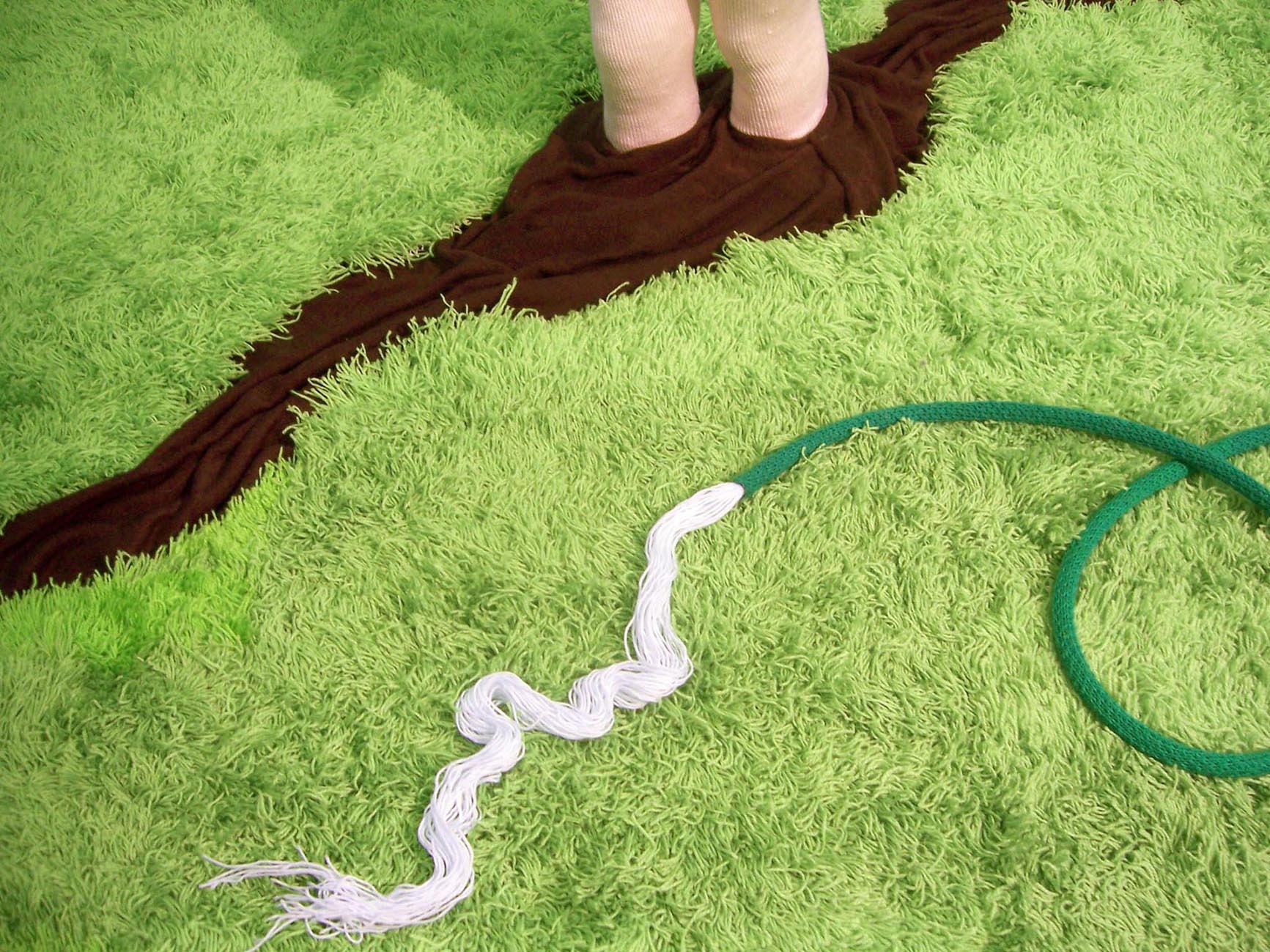Kate Just, KNITTED SCULPTURES 2003-2011
Exhibited at Penthouse and Pavement, Bus, West Space, Lake Macquarie Gallery, Conical, Melbourne Art Fair, Silvershot, TCB, RMIT Gallery, Margaret Lawrence Gallery, Canberra Contemporary Art Space, Don't Come Gallery, CAST, PICA, First Draft, MOP Projects, Bus Gallery, Gertrude Contemporary, Ararat Regional Gallery, Kunsthalle Krems, National Gallery of Australia
In my early sculptural works, I harnessed knitting's primarily evocation of the feminine and domestic to explore notions of gender, family and self identity. Textile crafts such as knitting are intrinsically tied to humanity in common language: we speak of social fabrics, of close-knit families and of falling apart at the seams. When anxious, we knit our brows and when our bones break, they knit themselves back together again. As a sculptural medium, knitting draws people together, entices them to touch, reminds them of childhood and breaks down physical boundaries between audience and work.
I was taught by my mother to knit at the age of twenty seven, following the death of my brother. Deeply affected by knitting's potential to weave stories of love, loss and family, I took up knitting as my primary medium. Uniform (Dad) was my first large scale knitted sculpture and pictures my father in his police uniform. Fertile Ground, a life-size knitted cornfield, refers to a place where I grew up and revisits the use of corn fields in American films as a symbol of mysticism, danger or spiritual power. LOVE was inspired by my interest in emotional and physical boundaries and territories. It sprung from memories of driving through frozen Connecticut, USA during Christmas, to see the lights and elaborate decorations put out in broad suburban yards. Created over a year, LOVE re-imagines a boundary hedge as a message of warmth and invitation. It also acts as a symbol of my resistance to policies of exclusion, as they continue to affect people from a diversity of religious, sexual, or ethnic backgrounds. Family is a knitted sculpture of my own family in the form of a ghostly tree. Family arose from childhood memories I had of climbing trees with my brother and sister; the tree reunites us after my brother’s his death.
In subsequent years, I created knitted sculptures reinterpreting Greek and other mythologies that deployed physical transformation as a metaphor for personal struggle, awakening sexuality and creative power. Through the creation of these time intensive works, I narrated difficult or significant life experiences, signalling knitting as a potent narrative or storytelling device. Paradise is a knitted scene that reinterpreted the myth of Persephone's descent into the underworld through a modern day, suburban image of a woman sinking into her own lawn. Persephone’s tale symbolically refers to a journey into the dark and unknown regions of the self. Continuing this theme, Paradise weaves an image of the grief shared by me and my mother over the death of my brother. My Daphne reimagines the myth of Apollo’s unrequited love of Daphne, and her chosen transformation into a laurel tree to reflect on my own experiences of coming out and migrating to Australia. I Just Don't Know What To Do With Myself draws on the Greek tale of Arachne, in which a duel between weaving women (Arachne and Athena) results in Arachne's attempted suicide and conversion into a spider. My despairing spider figure is characterised by glossy painted mannequin hands and flowing synthetic red locks, and reflects an experience of depression. Shed That Skin was inspired by paintings by Van der Goes, Michelangelo, Hieronymus Bosch and Tiepolo which image the serpent tempting Eve with fruits from the Tree of Knowledge. Biblical descriptions and these paintings portray the serpent as a beautiful woman on the top and a snake on the bottom. Shed My Skin sheds the skin of history which often marks women as conniving, evil or easily manipulated, and recasts the snake woman as an intimate, vulnerable reflection of myself. The Garden of Interior Delights is an ambitiously scaled knitted and sculptural reworking of the strange pink fountain from the first panel in Heironymus Bosch’s painting The Garden of Earthly Delights (c.1500). Bosch’s paradise is a fantastical one, featuring wildly imaginative structures that blend plant, body and man-made forms. While Art historians and theorists relate Bosch’s pink fountain to the alchemical sign of Cancer, a pelican, or the pink robed ‘God’ figure in the foreground of the painting, I reclaim and enlarge its uncanny resemblance to human reproductive organs. Sewn folds of hand and machine knitted fabric create tubes, polyps, and bodily orifices, while macramé suspension devices, feathers, and latch-hooked red rug fragments and liquid woolen spray invoke a hovering bodily totem.
This body of significant works was included in a survey exhibition at Ararat Regional Gallery entitled Kate Just: The Knitted Works 2004-2011. Read the exhibition essay by Anthony Camm here. Watch Kate Just interview about her work Uniform/Dad with the National Gallery of Australia, 2016 and this Kate Just interview about her work LOVE with the National Gallery of Australia, 2016.
-Kate Just




















